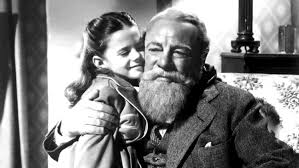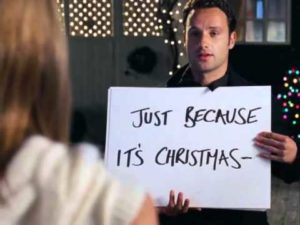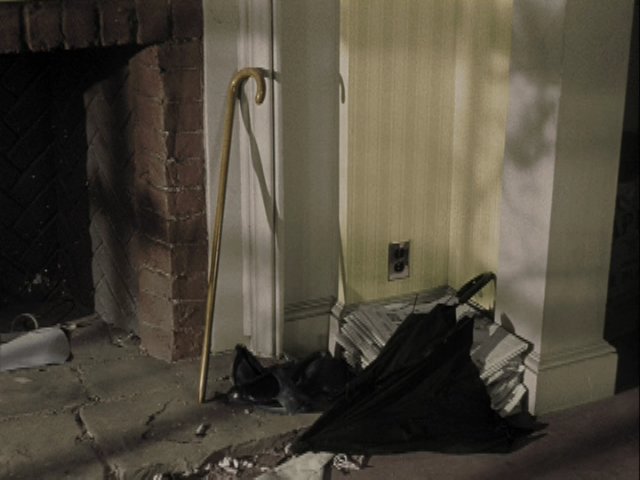If this choice for One Great Sentence seems odd, rest assured we're not going to go all holiday sappy on you. That's what the Hallmark holiday movie channels are for. Instead, when this line zipped by in my annual watching of "Miracle on 34th Street," I found myself thinking of it in terms of story craft.
For those who don't know the movie, I offer my sympathies, with hopes that you will soon address that lack. It's as classic as "It's a Wonderful Life," if not as quotable. The original 1947 version – the only one really worth watching – won three Oscars, including for best original story for Valentine Davies and best adapted screenplay for George Seaton. (Kris Kringle, played by Edmund Gwenn, took home the third for best supporting actor, although casting Santa Claus in a supporting role seems wrong. Very, very wrong.) For a movie made in the post-war blush of Rockwellian America, it is surprisingly modern: Maureen O'Hara as a jaded, driven career woman and single mom gives up nothing to Sheryl Sandberg; John Payne, as the idealistic lawyer who cracks open her hardened heart, doesn't hesitate to don on an apron. As for Natalie Wood as the child who is afraid to believe: The bubble gum scene alone is a grand bit of stagecraft.

That modernity is part of what makes it intriguing to think about "Miracle on 34th Street" through a journalistic prism. It is set in and captures, with great detail, a specific time and place. Yet it transcends those and becomes timeless. O'Hara is everyone who has been disappointed by love; Payne is everyone who has taken a leap of faith rather than shrink his soul. And young Natalie is every kid desperate to please but also starting to question the arbitrary nature of grown-up rules.
In other words, the story is built on archetypes. And while our journalism – or any good storytelling – should never sink to stereotypes (are you listening, Hallmark?), archetypes provide timeless and universal touchstones.
Framing all of that is a strong theme, yet the movie doesn't preach. Yeah, sure, Santa wins in the end. And yeah, he's Santa, so toys are celebrated. But the movie skirts any political or religious ideologies. I suppose some who fear that Christmas has been hijacked by secular interests could find offense. But I always see it as a seasonal reminder, in the deep, dark of winter, to gather close and be good to one another, and to believe in both the imperative and possibility of that goodness.
So what about that single, not-very-sophisticated sentence that started this riff? "We don't carry that brand, but I think Gimbel's does." What does it have to do with story craft, or even more, with journalism?
As simple as it is, it is a significant -- perhaps the significant – turn in the story. It's the line that shifts and launches the rest of the narrative. Plain as it is, it becomes a metaphor that, like the movie, is timeless.
It captures the essence of the entire story. It is, at core, a theme line, but not one that hits you with a brickbat. That happens in subsequent dialog in the movie, when a few scenes scream MEANING! but aren't nearly as deft as the small moment when a Macy's sales clerk is helping a frazzled customer find the right toy for her child. He thumbs through a catalog, then sends her to – gasp! – the competition.
And now, if you'll indulge me (it is the season, after all), that's where the true meaning of this movie comes together, for me, in a perfect overlay of journalism. It's a reminder that even a corporate giant like Macy's is nothing without the individual customer, and that profits derive from public service. Maybe Macy's loses a few rubles in the moment, but what they build is a deep well of good will that will pay far greater dividends down the road. That gesture gets Gimbel's to swallow hard and step up. The result: Together they do something neither could have done alone.
Even when journalism was a license to print money (those were the days), it was based on a primacy of public service. Even before Craig's List and the rest of the digital tsunami, much of traditional journalism had already abandoned that primacy to Wall Street, where ever-rising profits reign supreme. Even in the next several years, we stayed huddled in the denial of our newsrooms and failed to reach out to the very people we were doing this hard and necessary work for.
And even now – or maybe finally now – when so much seems like a Sisyphean scramble for survival, journalists are learning that collaboration wins. If we are fewer, we also are greater when we work together, and with the public we serve first in mind.
This is where I risk your eye-rolls, take a leap of faith and dare to believe. As they say in that other holiday classic, "Love Actually:" "Just because it's Christmas. ...And at Christmas you tell the truth."

PS: If you're still with me, please take note of the photo that leads this page. There's a stack of newspapers on the floor, right next to Santa's cane. Maybe they are there as fireplace starters, or maybe the former residents didn't finish cleaning when they left. But who cares? They are newspapers. How hopeful is that?



